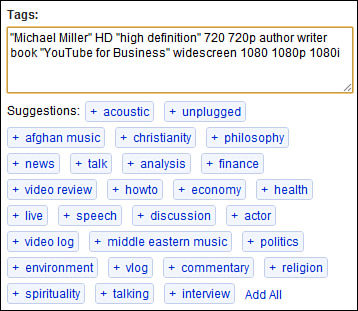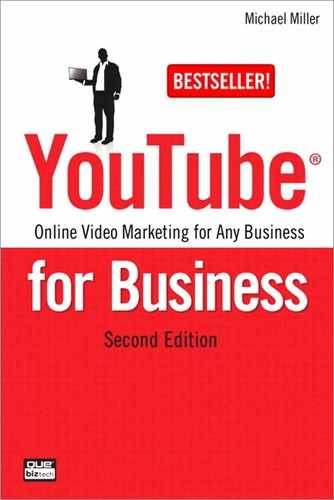21. Optimizing Your Videos for Search
How do people find your videos on YouTube? Most people discover new videos by searching for them—or rather, by searching for a particular topic or type of video. Those videos that display high in the search results get the views.
This means that you need to optimize your videos to rank as high as possible in YouTube’s search results. Video search optimization is similar to the search engine optimization (SEO) you perform on your website; it’s all about figuring out what people are searching for, and inserting those keywords into the appropriate places.
How YouTube Searches for Videos
Online search is all about keywords. A keyword is a word or phrase entered as part of a search query; it’s what people are searching for.
For example, if someone is looking for videos about sailboats, he might enter the keyword sailboat. If someone is looking for videos about meatloaf recipes, she might enter meatloaf recipe. If someone is interested in learning how to shoot a jump shot, he might enter how to shoot jump shot. You get the drift.
YouTube, then, tries to match the keywords entered by a user with those videos that best fit that query. In our first example, YouTube would display videos about sailboats; in the second, videos showing how to cook meatloaf; and in the third, videos that demonstrate how to shoot jump shots.
Just how does YouTube match queries to videos? Unfortunately, YouTube has no way of analyzing a video itself to determine its content; that technology does not yet exist. Instead, YouTube must rely on the description of the video to determine its content. That’s right, YouTube analyzes the text you enter to figure out what your video is about—and match it to the appropriate search queries.
As to exactly where YouTube looks, the answer is “everywhere”—everywhere that contains text, that is. That means you need to focus on three fields when uploading or editing your video: tags, title, and description. They all matter, to some degree, and will affect how your video is ranked when someone is searching for a related topic.
Choosing the Right Keywords
Whether we’re talking tags, title, or description, you need to determine the right keywords to use, and then include those keywords in all three fields, as best you can. It all revolves around the keywords, however.
It’s vital, then, that you learn how to create a list of keywords that best describe your video, in the way that users will think of and search for that video. It’s a matter of learning how to think like the customer; you need to get inside the heads of potential viewers to determine which words they’re using in their queries.
The art of determining which keywords to use is called keyword research, and it’s a key part of SEO, whether you’re optimizing your complete website or a single YouTube video. When you know which keywords and phrases that your target customers are likely to use, you can optimize the description of your video for those words and phrases; if you don’t know how they’re searching, you don’t know what to optimize.
It’s all a matter of determining how viewers search for the information they need. When you figure out the keywords they’ll most likely search for, you have the most effective keywords for your video.
You have to learn how customers think, and how they search. When someone is in the market for a new car, and trolling YouTube for useful information, how are they likely to search? If they’re just starting out, and don’t know what models best fit their needs, you’re likely to see queries that focus on particular features, such as four wheel drive sedan or hard top convertible or fuel efficient SUV. After customers narrow down their choices, they’re more likely to search for information about specific models, such as Ford pickup or BMW 3-series or Audi A5 convertible. You have to pick your keywords to match the stage at which you’re trying to reach these customers.
As such, you probably need to come up with a combination of both generic and specific keywords. For example, if your video talks about the differences between incandescent and fluorescent lighting, you should include generic tags such as lighting, light bulb, energy efficient, and the like, as well as more specific tags such as incandescent, fluorescent, and your company name. In this way, you attract viewers that are essentially browsing or just getting interested in the topic, as well as make yourself known to those viewers that have more specific needs in mind or are searching specifically for your company.
Optimizing Your Tags
After you come up with a list of keywords and phrases, just how do you use them? As noted earlier, there are three places where you can include keywords: your video’s tags, title, and description.
Let’s start with the Tag field first. What YouTube calls “tags” the rest of us call keywords; it’s just another term for the same thing. So naturally you should enter your keywords into the Tags field when you first upload your video, or later via the editing function.
As you can see in Figure 21.1, the Tags box has plenty of room for all the keywords you might want to target. Enter individual words with spaces in between. To enter a multiple-word phrase, enclose the phrase within quotation marks, like this: “multiple word phrase”.
Figure 21.1 Keywords entered into the Tags field for a YouTube video.

You’ll also note that YouTube recommends additional tags, beneath the Tags box. These are based on the tags you’ve previously entered and the video’s title and description. To add any of these suggestions to your official tags list, just click the tag.
The tags field is perhaps the most important for optimizing your video for search; it’s where YouTube looks first. Without the right tags, great content will go unfound. Add the appropriate tags, however, and you make it easier for viewers to find your videos.
Optimizing Your Title
YouTube also looks within your video’s title for keywords that match viewers’ queries. It’s more difficult to fit keywords into a title, however, because you’re limited as to the title’s length. Specifically, a title can include no more than 100 characters, so writing a title that is both descriptive and includes a number of keywords is challenging, to say the least.
But that’s part and parcel of SEO, in all its forms—learning how to incorporate your most important keywords into various text elements, while maintaining the usefulness and integrity of those text elements. Yes, it’s challenging, but it needs to be done.
This argues for taking some time to figure out the best titles for your videos. This isn’t something you want to do on the fly; it’s something that requires work.
The best titles describe the video’s content in a way that appeals to the target audience. They also include a handful of the most important keywords, those words that target viewers are most likely to be searching for. Ideally, these keywords are also the best descriptors of your video’s content.
What you don’t want to do is randomly insert keywords into the video’s title. One, that makes the title less descriptive, and thus less useful for prospective viewers. Two, it reeks of keyword stuffing, and YouTube won’t reward that. Instead, work the keywords into your title in an organic fashion; if you can’t do so, then don’t include them.
Optimizing Your Description
Finally, we come to the text description of your video. Here is yet another opportunity to include keywords that viewers might be searching for.
Adding keywords to your video’s description is much like performing SEO on your website’s body copy. You have lots of space to work with, so you’re not as limited as you are with the video’s title. Yet you still need to incorporate keywords in an organic fashion; they have to feel natural, not artificial.
Fortunately, it’s easier to work keywords into descriptive copy than it is into short titles. The extra length works wonders. Again, make sure that the keywords aren’t just inserted randomly, or in a list at the end of the description; that’s keyword stuffing, and that’s a no-no. Instead, write your copy to include as many keywords as genuinely fit. If your keywords are indeed descriptive of your video’s content, and not just chosen to attract a certain audience, then this shouldn’t be a problem.
Optimizing Embeds and Links
In traditional website SEO, the number of inbound links to page will increase that page’s ranking. The same thing goes for YouTube videos. The more web pages that link to your video, the more likely it is that your video will appear higher in YouTube’s search results. Likewise, you can increase your search ranking by getting your video embedded in more external web pages.
That’s right, links to and embeds of your video will affect its YouTube search rank. The challenge is, you have little control over how many sites link to or embed your video. That doesn’t mean you have no influence, however.
First, the more unique and authoritative the content in your video, the more likely it will be linked to or embedded. It all comes down to quality content; you need to make your video as “linkworthy” as possible.
In addition, you will want to encourage viewers to link to your video. The more you spread word of your video, the more people who will be exposed to it. Have your PR department push your video to influential bloggers, encouraging links or embeds. Email related websites and encourage them to embed or link to the video. Encourage recipients of your email mailing list, readers of your company blog, fans of your Facebook page, and followers of your Twitter feed to do the same. Get the word out and encourage as many links and embeds as possible.
Optimizing Views
Here’s another important factor in determining YouTube’s search rank—the number of times your video has been viewed. Fair or not, YouTube will rank a popular video higher than a less popular one. This is just another good reason to try to push more people to view your video, even though it’s admittedly a bit of a circular endeavor.
Optimizing Comments and Ratings
The final factor in YouTube’s search rank are the comments and ratings your video receives. A video with more comments and ratings (assuming it’s a net positive rating) will rank higher than one with fewer comments and ratings. For this reason, you need to activate comments and ratings for your videos, and then encourage viewers to voice their opinions.
The Big Picture
For your video to be found by the viewers you desire, it has to include those keywords that those viewers will be searching for. You should include these keywords in your video’s tags, title, and description; all these fields are used by YouTube to determine your video’s content. (Interestingly, YouTube can’t determine the content just by viewing the video; technology of that sort is still years away.)
YouTube also looks at the number of pages that link to or embed your video; the number of comments and ratings your video receives; and the total number of views of your video. In other words, the more popular a video is, the higher it will rank in YouTube’s search results—assuming it contains the appropriate keywords, of course.
